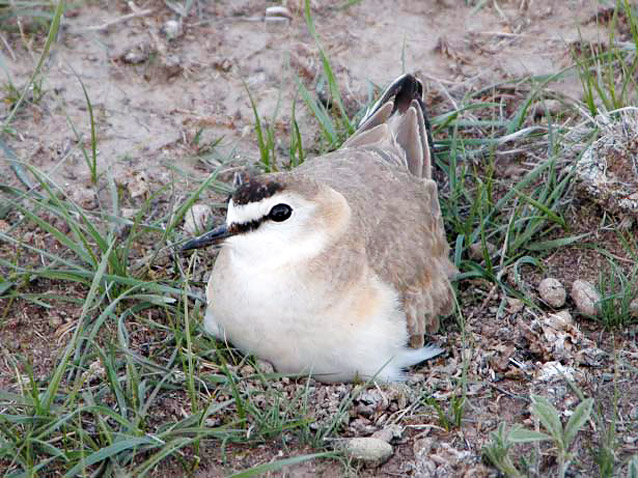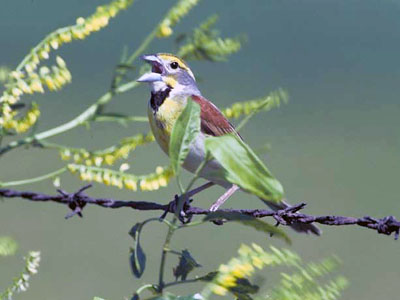Methods

© Victoria Dreitz
The Rocky Mountain Bird Observatory conducted the breeding bird inventory at Sand Creek Massacre National Historic Site (NHS) in spring and summer 2005. Sand Creek Massacre NHS is located in shortgrass prairie habitat in eastern Colorado and is comprised primarily of upland grassland and riparian habitat. The primary goal of the inventory was to determine the status of expected species not previously documented at the site. Inventory transects were established in upland sage and riparian habitat. Surveys were conducted when breeding birds were most likely to be detected on three separate days during the breeding season, late April through July. In addition, field observers visited and thoroughly searched every habitat in the park to search for new species including wetlands, rivers, creeks, and prairie dog towns.
Status
The diverse habitat and various conditions within Sand Creek Massacre NHS support the life history requirements of numerous species in various seasons. The site is a shortgrass prairie composed of two main habitats, riparian and upland shortgrass prairie, and a mosaic of conditions, including tall grass structure and prairie dog burrows. The site’s habitats and conditions are important to many bird species with a wide range of habitat needs. Riparian areas are locally and regionally important for migratory populations and provide necessary stopover habitat for long and short distance migrations, which are generally limited in shortgrass prairie ecosystems. Stopover habitat allows birds to replenish essential reserves for their flight to breeding areas. The combination of shortgrass prairie and riparian habitats in Sand Creek Massacre NHS are uncommon in shortgrass prairie ecosystems and are important to numerous species of birds, including several species of concern.
Researchers compiled a list of 59 documented bird species including two listed as species of special concern by Colorado: the burrowing owl (Athene cunicularia) and mountain plover (Charadrius montanus). Partners in Flight list sixteen of the detected species as species of conservation concern or stewardship species in the shortgrass prairie system conservation region. No federally listed species were detected.
The study detected species that require high grass structure such as short-eared owl (Asio flammeus) and dickcissel (Spiza americana), as well as species that prefer low grass structure and prairie dog burrows such as the burrowing owl and mountain plover. Birds detected during the survey represent a diversity of habitat use in the site. This mix of birds suggests the shortgrass prairie habitat mosaic is healthy.

© Steve Maslowski
Stopover locations such as the site’s riparian habitat are limited in the shortgrass prairie and are vital to long- and short-distance migratory birds. Several species were documented using the riparian habitats, though they do not breed in the area: chestnut-sided warbler (Setophaga pensylvanica), clay-colored sparrow (Spizella pallida), hermit thrush (Catharus guttatus), indigo bunting (Passerina cyanea), Lincoln’s sparrow (Melospiza lincolnii), and Swainson’s thrush (Catharus ustulatus). Riparian areas also provide suitable habitat for many probable breeding species, the most common being Western kingbird (Tyrannus verticalis), orchard oriole (Icterus spurius), and mourning dove (Zenaida macroura). The red-headed woodpecker (Melanerpes erythrocephalus), a less common species and a species of conservation concern listed by Partners in Flight, was detected and is also a probable breeding species in the riparian habitat. Several Western meadowlarks (Sturnella neglecta), a common species, were detected during the study and prefer upland habitats, which are present in the site’s open riparian habitat.
The upland habitats also host many species listed in the Partners in Flight program. These species include the Cassin’s sparrow (Peucaea cassinii), dickcissel, grasshopper sparrow (Ammodramus savannarum), horned lark (Eremophila alpestris), lark bunting (Calamospiza melanocorys), lark sparrow (Chondestes grammacus), Northern harrier (Circus cyaneus), Say’s phoebe (Sayornis saya), scaled quail (Callipepla squamata), short-eared owl, Swainson’s hawk (Buteo swainsoni), Western kingbird, and Western meadowlark.
Sand creek massacre NHS could potentially support other species during their life history. These species include the ferruginous hawk (Buteo regalis), golden eagle (Aquila chrysaetos), lesser prairie chicken (Tympanuchus pallidiicinctus), prairie falcon (Falco mexicanus), long-billed curlew (Numenius americanus), and Northern bobwhite (Colinus virginianus), though they were not detected during the survey.
Contacts
David Hanni, Monitoring Division, Rocky Mountain Bird Observatory, Fort Collins, Colorado.
Reference
Hanni, D. and Rocky Mountain Bird Observatory. 2006. Sand Creek Massacre National Historic Site Inventory and Monitoring Final Report. Brighton, CO.
Prepared by the Southern Plains Network Inventory and Monitoring Program, 2015.
Part of a series of articles titled Southern Plains Bird Inventories.
Previous: Pecos Breeding Bird Inventory
Last updated: February 1, 2017
